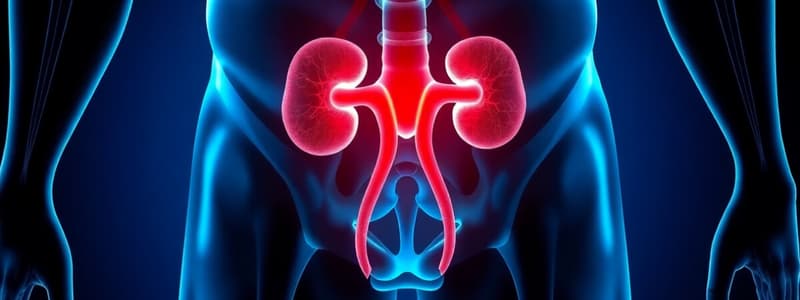Podcast
Questions and Answers
What are the first and second most common zones from where prostate cancer arises?
What are the first and second most common zones from where prostate cancer arises?
- Central then transitional
- Peripheral then transitional (correct)
- Transitional then central
- Central then peripheral
- Peripheral then central (correct)
Enuresis nocturnal can have:
Enuresis nocturnal can have:
- Congenital diseases of the excretory system (correct)
- Emotional liability (correct)
- Normal up to 5-6 years of age (correct)
- In neurological diseases (spina bifida etc.) (correct)
- Carcinoma of the prostate
Treatment of urinary incontinence includes:
Treatment of urinary incontinence includes:
- Kegel exercises (correct)
- Medications
- Surgery
- Lifestyle changes
- All of the above (correct)
The most important risk factor for prostate cancer is:
The most important risk factor for prostate cancer is:
The most common type according to the chemical composition of stone is:
The most common type according to the chemical composition of stone is:
TUR syndrome is due to:
TUR syndrome is due to:
The normal frequency of urination for an adult in 1 day is:
The normal frequency of urination for an adult in 1 day is:
A recurrent urinary tract infection is defined as:
A recurrent urinary tract infection is defined as:
From which part of the epididymis does the vas deferens begin?
From which part of the epididymis does the vas deferens begin?
A potentially malignant cyst graded as Bosniak III grade is:
A potentially malignant cyst graded as Bosniak III grade is:
Define oligozoospermia:
Define oligozoospermia:
What is the last stage in the embryonic development in the urinary system?
What is the last stage in the embryonic development in the urinary system?
What are the penile anomalies?
What are the penile anomalies?
What are the risk factors for bladder carcinoma?
What are the risk factors for bladder carcinoma?
What are the types of pyelonephritis?
What are the types of pyelonephritis?
What might happen next to this boy if he is not treated?
What might happen next to this boy if he is not treated?
Which cancer has the best prognosis?
Which cancer has the best prognosis?
Which of the congenital disorders usually doesn't need treatment?
Which of the congenital disorders usually doesn't need treatment?
What are the risk factors for renal cell carcinoma?
What are the risk factors for renal cell carcinoma?
Which of the following are risk factors for cryptorchidism?
Which of the following are risk factors for cryptorchidism?
Up to what age is enuresis considered a physiological condition?
Up to what age is enuresis considered a physiological condition?
Which embryonic structure is the final stage in the development of the kidney?
Which embryonic structure is the final stage in the development of the kidney?
Which of the following are zones of the prostate?
Which of the following are zones of the prostate?
Which stone has the highest density (most X-ray positive)?
Which stone has the highest density (most X-ray positive)?
Which medications indirectly form stones?
Which medications indirectly form stones?
What are the treatment principles for kidney trauma?
What are the treatment principles for kidney trauma?
Match the following medications to their classifications:
Match the following medications to their classifications:
Flashcards are hidden until you start studying
Study Notes
Prostate Cancer and Urinary Incontinence
- Prostate cancer primarily arises from the peripheral zone, followed by the transitional zone.
- Urinary incontinence can be treated with Kegel exercises to strengthen pelvic floor muscles.
- The most significant risk factor for prostate cancer is age, with genetic predisposition also playing a crucial role.
- Most common stone type observed in urolithiasis is calcium oxalate.
Urinary Tract and Kidney Conditions
- A recurrent urinary tract infection is defined as occurring twice in 6 months or three times in a year.
- TUR syndrome occurs due to hyponatremia.
- Normal adult urination frequency is considered to be 6-8 times per day.
Epididymis, Sperm Production, and Embryonic Kidney Development
- The vas deferens originates from the tail of the epididymis.
- Oligozoospermia is defined as having less than 15 million sperm per milliliter.
- The final stage in urinary embryonic development is the metanephros.
Penile Anomalies and Bladder Carcinoma Risk Factors
- Common penile anomalies include hypospadias, epispadias, and penile torsion.
- Risk factors for bladder carcinoma encompass smoking, chronic irritation, and exposure to carcinogenic chemicals.
Types and Diagnosis of Pyelonephritis
- There are two main types of pyelonephritis: acute and chronic.
- Clinical presentations for these types vary; acute is typically characterized by fever and flank pain, while chronic may show less intense symptoms but leads to renal damage.
Tumor Markers and Bladder Biopsy Techniques
- Common tumor markers include PSA, alpha-fetoprotein, and LDH.
- A bladder biopsy is conducted through a cystoscope for direct visualization and sampling.
Stone Formation Inhibitors and Urinary Catheter Use
- Inhibitors of stone formation include citrate, magnesium, and pyrophosphate.
- Urinary catheters are lubricated to prevent trauma to the urethra and reduce the risk of infection.
Congenital Anomalies and Obesity-Related Cancers
- Prenatal ultrasound can detect several congenital anomalies, such as renal agenesis and hypospadias.
- Obesity and hypertension are associated with increased risks for several cancers, including renal cell carcinoma.
Testicular and Urethral Disorders
- Cryptorchidism increases risks for testicular torsion, inguinal hernia, and testicular cancer.
- In cases of ureteral injury, diagnosis involves imaging studies following trauma, and treatment can range from conservative management to surgical intervention.
Common Causes of Acute Scrotal Pain
- Conditions included in acute scrotum: testicular torsion, acute epididymitis, and Fournier's gangrene.
Hormonal Levels in Klinefelter Syndrome
- Klinefelter syndrome presents with elevated LH and FSH levels and decreased testosterone.
Urological Treatment Principles
- Treatment principles for kidney trauma include conservative management (monitoring and medications) and surgical intervention for significant injuries.
- Erectile dysfunction treatment follows a step-wise approach: starting with 5-PDE inhibitors like Sildenafil.
Risk Factors and Definitions
- Non-selective alpha-blockers can cause orthostatic hypotension and include medications like Doxazosin and Terazosin.
- Enuresis is considered physiological up until the age of 5 years.
Studying That Suits You
Use AI to generate personalized quizzes and flashcards to suit your learning preferences.




